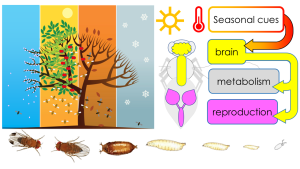Project No.2477
STANDARD PROJECT
Primary Supervisor
Dr Herman Wijnen – University of Southampton
Co-Supervisor(s)
Dr Michelle Fountain – NIAB East Malling
Dr Samuel Robson – University of Portsmouth
Dr Orestis Katsamenis – University of Southampton
Summary
Drosophila suzukii, also known as spotted wing Drosophila (SWD), is an invasive pest that has global economical impacts on soft and stone fruit growers.
SWD’s success as an invasive species is enhanced by its ability to exploit ripening fruit as an egg laying substrate as well as its ability to overwinter in temperate climates. Under conditions with colder temperatures and shorter day lengths SWD hatches as winter morph flies with longer wings and increased pigmentation. These winter morph flies show improved survival upon exposure to (near-)freezing temperatures. As winter morph flies are responsible for re-establishing new breeding populations in spring, an improved understanding of their development and properties can inform pest management strategies targeting this seasonal stage. Prior studies described the impact of different environmental conditions on SWD oviposition and locomotor activity (Shaw et al., PLoS one, 2018; J Biol Rhythms, 2019). This project aims to 1) Identify the separate and combined impact of winter-like conditions and the winter morph stage on survival, feeding, fecundity and tissue organization and 2) Identify molecular pathways involved in winter morph development and adaptiveness. Transcriptome changes in SWD summer and winter morph flies will be studied in response to different light and temperature cycles with a defined impact on fecundity, activity patterns and survival. Gene expression changes in this context will also be explored with the help of available antibodies to relevant Drosophila neuropeptides and regulatory proteins. Finally, genetic manipulation of genes linked to seasonal polyphenism in SWD or its close relative D. melanogaster will be used to identify underlying mechanisms. This multi-disciplinary project offers excellent training opportunities in pest ecology, neurogenetics, correlative imaging and functional genomics.
This project is a great fit for student applicants with a strong academic record, a good level of computing skills and research experience in one or more relevant areas of biological sciences.

